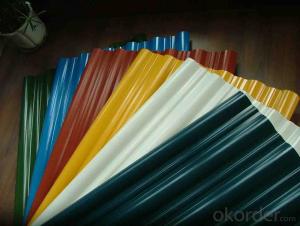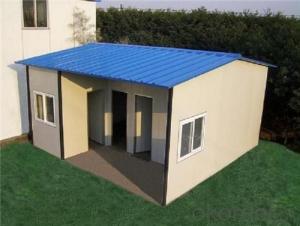Steel Sheet Roof Tile,Corrugated Steel Roof Plate,Color Steel Plate
- Loading Port:
- Nanjing
- Payment Terms:
- TT OR LC
- Min Order Qty:
- 2000 PCS
- Supply Capability:
- 30000 PCS/month
OKorder Service Pledge
OKorder Financial Service
You Might Also Like
Steel Sheet Roof Tile,Corrugated Steel Roof Plate,Color Steel Plate Details
Standard: | AISI,ASTM,BS,DIN,GB,JIS | Grade: | Corrugated Sheet Coil |
Place of Origin: | Hebei China (Mainland) | Thickness: | 0.13-1.2mm |
Technique: | Cold Rolled | Surface Treatment: | Galvanized |
Special Use: | Wear Resistant Steel | Width: | 310-1250mm |
Color: | Blue/Red/Green/Grey etc | Price: | Cheap Direct Factory Price |
Stock: | Big Quantity | Factory Visit: | Available |
Length: | 1000-6000mm,Coustomized | Name: | Hot Rolled Roofing Sheet |
Packaging & Delivery
Packaging Detail: | Waterproof paper, galvanized steel covered and steel strip packed for Hot Rolled Roofing Sheet |
Delivery Detail: | 10-15 days |
Steel Sheet Roof Tile,Corrugated Steel Roof Plate,Color Steel Plate Specifications
Steel Sheet Roof Tile,Corrugated Steel Roof Plate
Hot Rolled Metal Sheets
Usage: Walls, roofing
Excellent anti-corrosion
Item | Factory Hot Rolled Roofing Sheet |
Grade | SGCC SGCH HRB>85, SGLCC, DX51D+Z/AZ, |
Standard | ASTM A653M-04/JIS G3302/DIN EN10143/GBT 2518-2008 AS1397-2001, EN10215-1995, ASTM A792M-02, JIS G3321-1998 |
Basal plate | Cold rolled steel coil ,hot dipped galvanized/galvalume steel coil |
Zinc Coating | 60g/m2-175g/m2 |
Thickness | 0.13-1.0mm |
Width | 750-1250mm(before corrugation) 600-1000mm(after corrugation) |
Length | 1500-16000mm |
Number of corrugation | 7-12 |
Product feature | water resistance,light weight,easy installation,aesthetic,high tensile |
Packing | standard export water-proof package with steel strips fixed |
Delivery time | 10-25 days after confirmation |
Weight per Steel Pallet | 3 Metric Tons |
MOQ | 5 Metric Tons |
HS Code | 7210700000 |
Application | exterior and interior wall,roofs,sandwich plate and soffits |
Advantages | 1.Design according to customers 'requirements 2.Production under ISO9001-2008 Quality System 3.Easy to be installed as light weight 4.Z60-275/AZ30-150 is suitable for many application 5.Our products are recyclable materials 6.The less construction period, the more using time. |
Steel Sheet Roof Tile,Corrugated Steel Roof Plate,Color Steel Plate Pictures
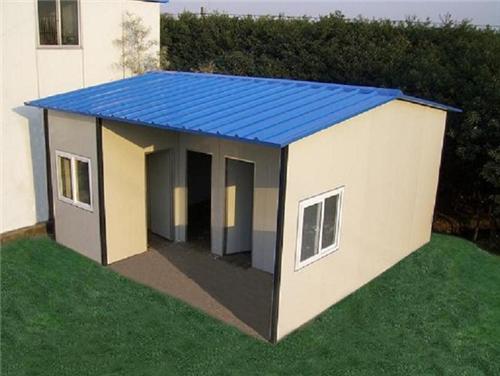
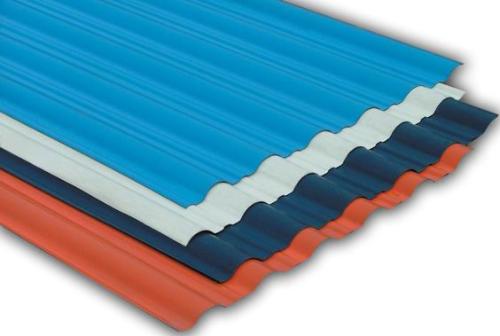
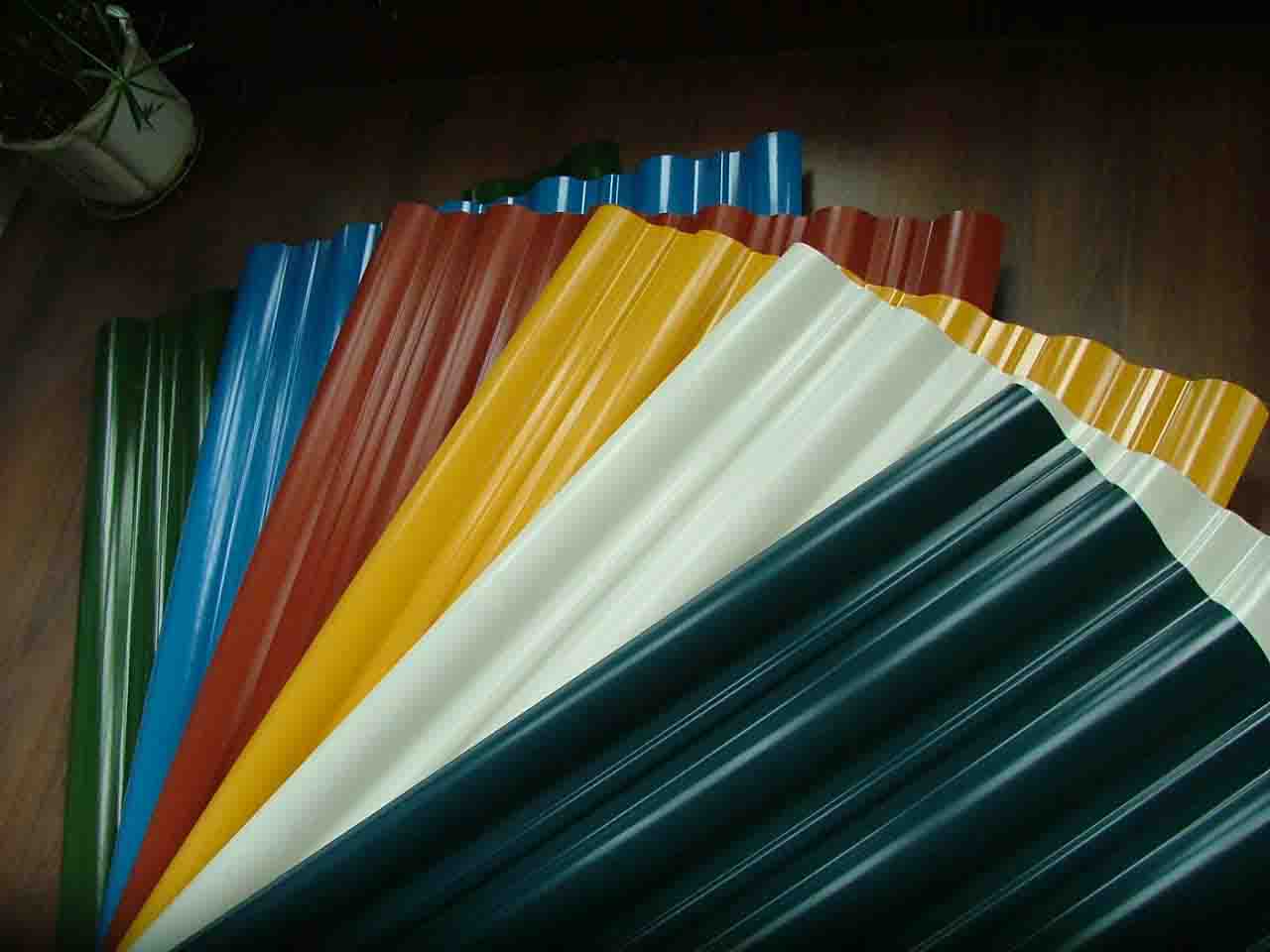
- Q:What is the impact resistance of galvanized steel sheets?
- Galvanized steel sheets have excellent impact resistance due to their strong and durable zinc coating. This coating provides an added layer of protection, making the steel more resistant to dents, scratches, and other forms of physical damage. As a result, galvanized steel sheets are commonly used in applications that require high impact resistance, such as automotive body panels, construction materials, and industrial equipment.
- Q:What are the different types of surface treatments available for steel sheets?
- There are several different types of surface treatments available for steel sheets, each serving a specific purpose and offering unique benefits. 1. Hot-dip galvanizing: This is a widely used method where steel sheets are dipped in a bath of molten zinc, creating a protective coating that prevents corrosion. Hot-dip galvanizing provides excellent corrosion resistance and durability. 2. Electro-galvanizing: In this process, a layer of zinc is electrochemically deposited onto the steel sheets, creating a thin, uniform coating. Electro-galvanizing provides good corrosion protection and is often used for decorative purposes. 3. Powder coating: This surface treatment involves applying a dry powder onto the steel sheets and then curing it using heat. Powder coating provides a durable and attractive finish, offering protection against corrosion, UV rays, and chemicals. 4. Paint coating: Steel sheets can be coated with various types of paints, including epoxy, polyurethane, and polyester. Paint coatings provide aesthetic appeal and offer protection against corrosion and weathering. 5. Phosphating: This treatment involves applying a phosphate coating to the steel sheets, which enhances their corrosion resistance and improves paint adhesion. Phosphating is often used as a pre-treatment before painting or powder coating. 6. Chromate conversion coating: Also known as chromating or passivation, this treatment involves applying a thin layer of chromate onto the steel sheets. Chromate conversion coatings enhance corrosion resistance and improve paint adhesion. 7. Anodizing: Although primarily used for aluminum, anodizing can also be applied to steel sheets. This process involves creating an oxide layer on the surface of the steel, which enhances corrosion resistance and provides a decorative finish. 8. Pickling: This treatment involves immersing the steel sheets in an acidic solution to remove scale, rust, and other impurities. Pickling leaves the steel sheets with a clean, smooth surface, ready for subsequent treatments or processes. Overall, the choice of surface treatment for steel sheets depends on the intended application, desired appearance, and level of corrosion resistance required.
- Q:What is the average price of a steel sheet?
- Several factors, including size, thickness, quality, and market conditions, can cause the average price of a steel sheet to fluctuate. Typically, steel sheets can be priced anywhere from $500 to $1500 per ton. Nevertheless, it's crucial to bear in mind that prices may vary due to global demand, production costs, and trade policies. Moreover, various suppliers may present different price points, making it wise to compare prices from multiple sources prior to making a purchase decision.
- Q:Do steel sheets have any magnetic properties?
- Yes, steel sheets do have magnetic properties. Steel is an alloy composed primarily of iron, carbon, and other elements, and it is known to be ferromagnetic. This means that it can be magnetized and attracts magnets. However, the degree of magnetism in steel can vary depending on its composition and processing. Some steel alloys can be easily magnetized and retain their magnetism even after the applied magnetic field is removed, while others may have lower magnetic properties. The presence of impurities and the specific heat treatment process can also affect the magnetic properties of steel. Overall, steel sheets can exhibit magnetic properties, but the degree of magnetism may vary depending on the specific type and composition of the steel.
- Q:Can steel sheets be painted or powder-coated after installation?
- Yes, steel sheets can be painted or powder-coated after installation. This allows for customization and protection against corrosion or other environmental factors.
- Q:What is the typical electrical conductivity of a steel sheet?
- The typical electrical conductivity of a steel sheet is relatively low compared to other metals. Steel is considered to be a poor conductor of electricity, with a conductivity ranging from 6.99 to 9.71 million siemens per meter (MS/m), depending on the specific type and composition of the steel.
- Q:What are the safety considerations when working with steel sheets?
- When working with steel sheets, it is important to keep several safety considerations in mind: 1. Personal Protective Equipment (PPE) is crucial for protecting yourself from potential hazards. This includes safety glasses or goggles, gloves, steel-toed boots, and a hard hat. 2. When lifting and handling steel sheets, use proper techniques such as bending your knees and keeping your back straight. Alternatively, you can utilize mechanical lifting equipment like cranes or forklifts. Avoid attempting to lift sheets that are too heavy for you alone. 3. Be mindful of slips, trips, and falls on slippery surfaces created by steel sheets, especially when they are wet or oily. Keep work areas clean and free of debris, and use non-slip mats or flooring when necessary. Pay attention to trip hazards like cords or tools and exercise caution when moving around the work area. 4. Take care when handling steel sheets with sharp edges and corners to avoid cuts or injuries. Wear gloves to protect your hands and if needed, use edge protectors or file down sharp edges to reduce the risk of harm. 5. Steel sheets can be flammable when exposed to high temperatures or sparks. Ensure that work areas are free of flammable materials and follow proper fire safety procedures. It is important to have fire extinguishers readily available and know how to use them. 6. Working with steel sheets can generate significant noise and vibration. Protect your hearing by wearing earplugs or earmuffs. If using power tools, make sure they are well-maintained and have vibration-dampening features to minimize the risk of hand-arm vibration syndrome. 7. Adequate ventilation is necessary when working with steel sheets that may release fumes or dust when cut or welded. Ensure that the workspace is well-ventilated to prevent the accumulation of harmful gases or particles. If necessary, use exhaust fans or wear respiratory protection to avoid inhaling hazardous substances. By adhering to these safety considerations, you can reduce the risks associated with working with steel sheets and promote a safer work environment for yourself and others.
- Q:What is the difference between a black and pickled steel sheet?
- The main difference between a black steel sheet and a pickled steel sheet lies in the surface finish and the process they undergo. A black steel sheet, also known as hot-rolled steel, is produced through a process called hot rolling. During this process, the steel is heated above its recrystallization temperature and passed through rollers to achieve the desired thickness. The resulting sheet has a dark, rough, and scaly surface, hence the term "black steel." The black surface is a result of the oxidation that occurs during the hot rolling process. On the other hand, a pickled steel sheet is produced through a process called pickling. After hot rolling, the black steel sheet undergoes a treatment where it is immersed in an acidic solution, typically hydrochloric acid or sulfuric acid. This pickling process removes the oxide scale from the surface of the black steel sheet, resulting in a smooth and clean surface. The pickling process also helps to improve the steel's corrosion resistance. The choice between a black steel sheet and a pickled steel sheet depends on the intended application. Black steel sheets are often preferred for structural components, such as beams and columns, where surface appearance is not a critical factor. Pickled steel sheets, with their smooth and clean surface, are commonly used in applications where a high-quality finish is required, such as automotive panels, appliances, and architectural elements. In summary, the key difference between a black steel sheet and a pickled steel sheet is the surface finish. The black steel sheet has a rough and scaly surface due to oxidation during hot rolling, while the pickled steel sheet has a smooth and clean surface after undergoing a pickling process to remove the oxide scale.
- Q:Can the steel sheets be easily painted or coated?
- Yes, steel sheets can be easily painted or coated.
- Q:How do you cut a steel sheet?
- In order to cut a steel sheet, it is necessary to utilize the correct tools and techniques. The following are several commonly employed methods: 1. Power tools: An angle grinder equipped with a cutting disc is the most frequently used power tool for cutting steel sheets. While operating the grinder, it is essential to wear safety goggles and gloves. Begin by marking the cutting line on the sheet using a marker or chalk. Then, slowly and steadily maneuver the grinder along the marked line to cut through the steel. 2. Shears: For thin steel sheets, manual or electric shears can be employed. These tools possess a scissor-like cutting mechanism specifically designed for cutting metal. Position the steel sheet between the shears' blades, aligning the cutting line with them, and apply consistent pressure to cut through the sheet. 3. Plasma cutting: This technique is most suitable for thicker steel sheets. Plasma cutting involves the utilization of a high-velocity jet of ionized gas (plasma) to melt and sever the metal. Specialized equipment, such as a plasma cutter utilizing an electric arc to generate the plasma jet, is necessary for this method. 4. Waterjet cutting: Another effective method for cutting steel sheets is waterjet cutting. This method employs a high-pressure jet of water mixed with an abrasive substance, such as garnet, to cut through the metal. Although this technique is ideal for intricate shapes and precise cuts, it requires specialized machinery. Prioritizing safety is of utmost importance before attempting to cut a steel sheet. It is crucial to wear suitable protective gear, like safety glasses, gloves, and, if necessary, a face shield. Additionally, ensure that the work area is well-ventilated to prevent inhaling any fumes or particles produced during the cutting process.
1. Manufacturer Overview |
|
|---|---|
| Location | |
| Year Established | |
| Annual Output Value | |
| Main Markets | |
| Company Certifications | |
2. Manufacturer Certificates |
|
|---|---|
| a) Certification Name | |
| Range | |
| Reference | |
| Validity Period | |
3. Manufacturer Capability |
|
|---|---|
| a)Trade Capacity | |
| Nearest Port | |
| Export Percentage | |
| No.of Employees in Trade Department | |
| Language Spoken: | |
| b)Factory Information | |
| Factory Size: | |
| No. of Production Lines | |
| Contract Manufacturing | |
| Product Price Range | |
Send your message to us
Steel Sheet Roof Tile,Corrugated Steel Roof Plate,Color Steel Plate
- Loading Port:
- Nanjing
- Payment Terms:
- TT OR LC
- Min Order Qty:
- 2000 PCS
- Supply Capability:
- 30000 PCS/month
OKorder Service Pledge
OKorder Financial Service
Similar products
New products
Hot products
Related keywords
